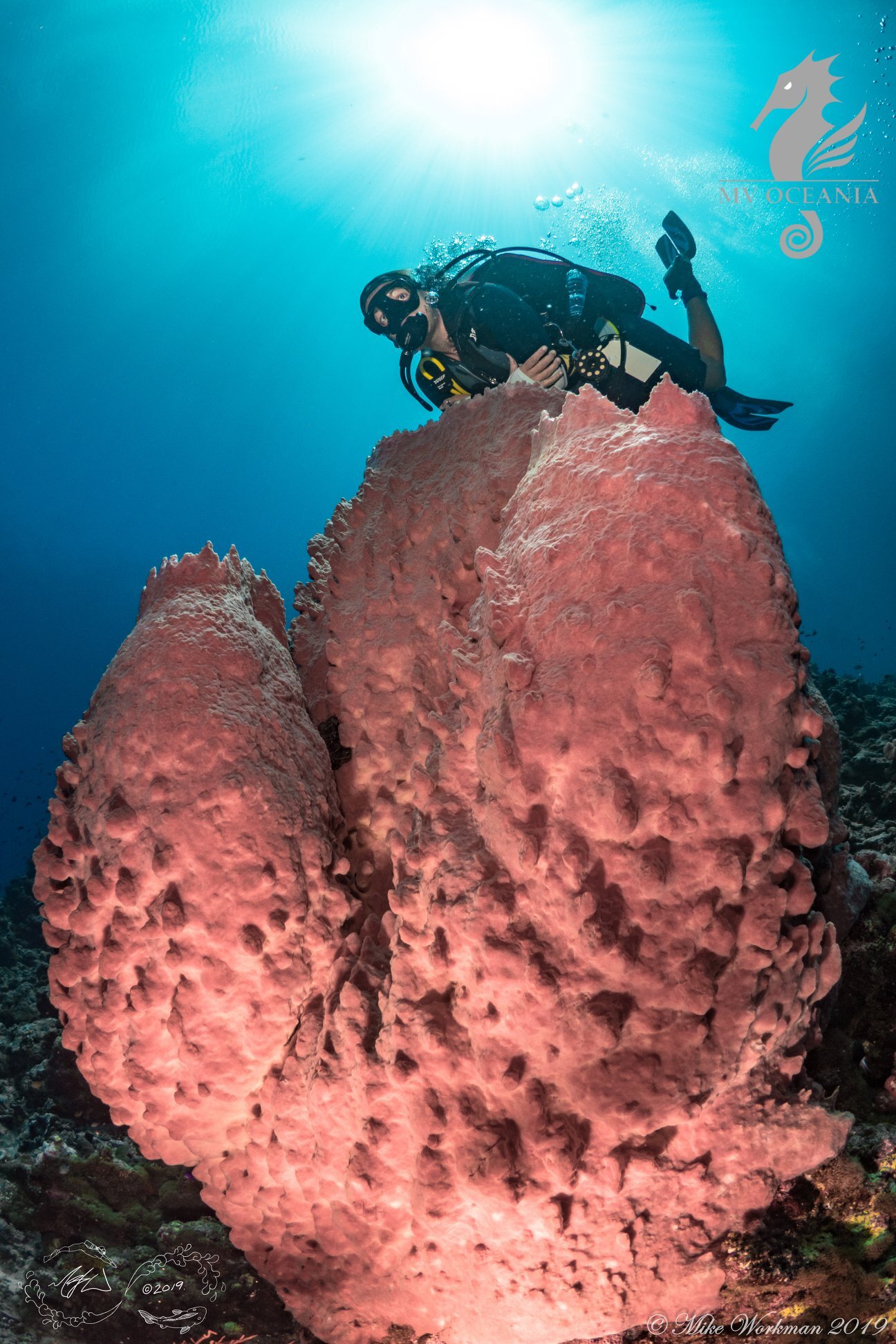Kimbe Bay Diving
KIMBE BAY
Kimbe Bay is home to some of the healthiest coral, as well as some of the largest diversion of both coral and fish anywhere on the planet.
Prof Charles Veron, former chief scientist of the Australian Institute of Marine Science had this to say - "The coral reefs of Kimbe Bay take me back forty years to a time when corals grew in lush profusion, untroubled by the problems that beset them today ..."
Below are some images taken on board Oceania in Kimbe Bay by trip director Mike Workman.
Below the gallery, find descriptions of some of our most popular dive sites in Kimbe Bay.




















Susan's Reef
Dense stands of Red Sea Whips (Ellisella sp.) give Susan's Reef a unique aesthetic quality that sets it apart from other Walindi reefs. A stunning collection of corals is particularly rich at the southern end of the reef including large gorgonian fans, red sea whips and elephant ear sponges, everything adorned with colorful crinoids - a delight to all who dive here.
Inglis Shoal
Inglis Shoal rises from very deep water to within 11 metres of the surface and is very rich in fish life. Pelagic fish species are common and include Dogtooth Tuna, Barracuda and Bigeye Trevally. Scalloped Hammerheads and Grey Reef Sharks are sometimes seen at Inglis Shoal.
Otto's Reef
This large reef, being isolated from any other reef or land mass, is entirely different to any other Walindi dive sites. On days when the current is creating eddies on the point, schools of barracuda, trevally, sea perch, fusilier, unicorn fish and surgeon fish mix with a variety of shark species and tuna, resulting in plenty of exciting action.
Christine's Reef
Christine's Reef is a collection of reefs joined by underwater ridges to form a large horseshoe shape complex. A photographer's paradies, Chirstine's features a beautiful collection of extremely large barrel sponges, many different gorgonian fan corals and red whip gorgonians. As with all Kimbe Bay reefs, reef associated fishes are abundant and diverse.
Restorf Island
The waters around Restorf Island hold an incredible diversity of marine life. It would be possible to spend a week diving here and still find new things in the various habitat types around the island. Depth is from the surface, down to 32 metres and this site is one of the many that are also excellent for snorkeling.
Vanessa's Reef
Vanessa's is a submerged shoulder that extends westward off a much larger reef at a depth of fifty to sixty feet. It's primary attractions are a multitude of large dark red gorgonian sea fans and further out on the shoulder, a sponge garden featuring many huge elephant ear sponges, a few barrel sponges and bright orange sponge mounds.
Joelle’s reef
Joelle’s is one of the bays outer edge sea mounts, crowded with circling schooling fish. pinjalo snappers, jacks and chevron barracuda swirl above the reef top which is dotted with brightly coloured balled up anemones. Occasionally a reef shark or two can be spotted patrolling the edge of the mount, and batfish join divers on their safety stop before surfacing.
Anne Sophies
The top of Anne Sophies is in about 5m of water, divers follow the contour of the reef as it slopes off down to a sandy bottom with a maximum depth around 23m. This site is adorned with a variety of beautiful soft corals, gorgonian fans and orange sponges. Jacks, batfish and barracudas can be found in the waters around the reef, while large Funeris nudibranch, garden eels and goby shrimp can be found near the sandy floor.
The Zero
The Zero is a Japanese aircraft wreck - perfectly preserved in shallow water. Aside from the aircraft itself, divers can explore coral bommies, home to Juvenile lionfish, eight banded butterfly fish, signal gobies, lobsters and stonefish. Note that the wreck sits on a silt bottom, so this dive is weather dependant and is best only dived in small groups.
South Ema
South Ema is a swim through decorated with beautiful rope sponges, soft corals, fan gorgonians. The top of the reef has many different species of hard corals and fish.
ITINERARIES & WEATHER PATTERNS
MV Oceania will run a few different kinds of itineraries during the year to suit the weather patterns of each season.
Our "Signature Itinerary" covers our three most popular diving areas of Kimbe Bay, Witu Islands and Fathers Reefs. MV Oceania will operate 10 and 9 night Signature itineraries in our ‘peak' weather months, from mid September, October and November along with April, May and June. Water temperatures are slightly lower in September, October and November and that means there are usually more of the smaller and unusual critters about.
Water temperatures are usually 29/30 degrees celsius in the later months, and up to 31 degrees in April and May. There is usually very little rain in October & November (there is a possibility of a couple of evening showers here and there), light breezes and plenty of sunshine.
Our "Mid Year" itineraries usually operate through June, July and August and are shorter in duration with each trip being around 8 days. This itinerary visits 2 dive areas including Kimbe Bay Reefs and either Fathers Reefs or Witu Islands. During late November and early December we offer a Witu Islands Itinerary, visiting Kimbe Bay Reefs and the pretty coral reefs and black sand bays of the Witu Islands.
Throughout the year MV Oceania will offer occasional specialist itineraries within the Bismarck sea and further afield. Don’t hesitate to get in touch with our friendly reservations staff to find an itinerary that suits you.